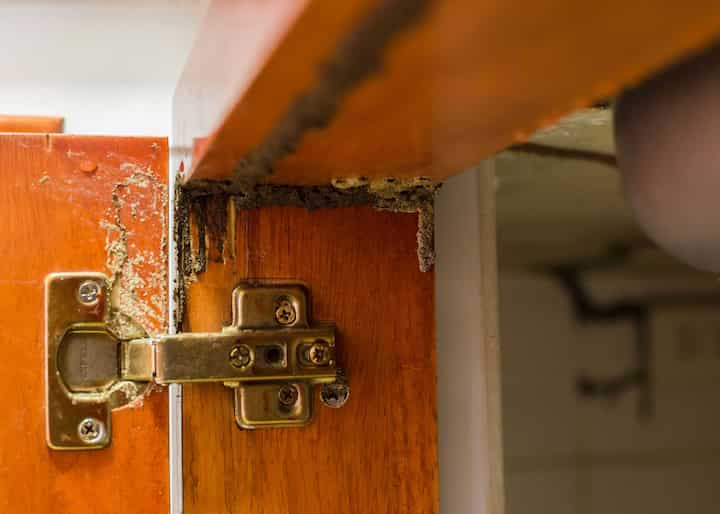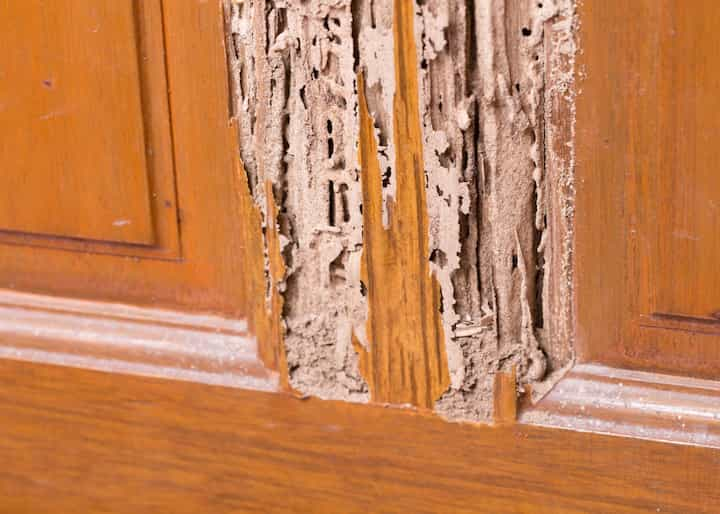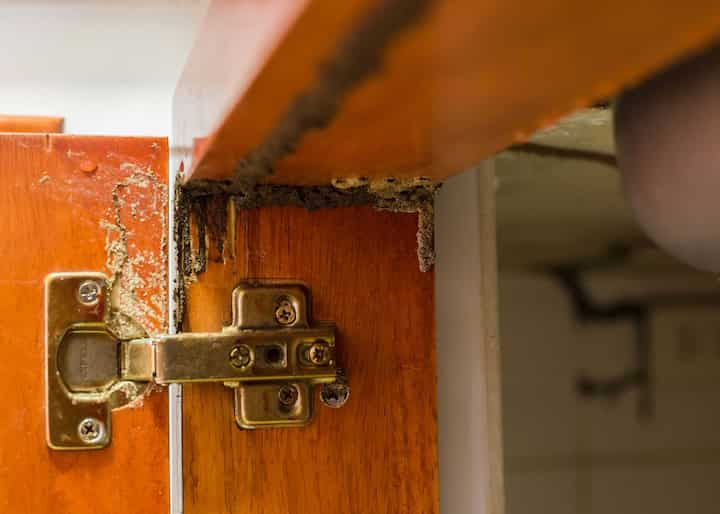Don't let termites destroy your home: protect it now with our expert help

## Termites: A Comprehensive Guide to Identification, Prevention, and Treatment
What Are Termites?
Termites are wood-boring insects that belong to the order Blattodea, which also includes cockroaches. They are commonly known as “white ants” due to their pale coloring, but they are in fact more closely related to termites. Termites live in complex colonies with diverse castes, including workers, soldiers, and reproductives. These insects are found worldwide and can infest a wide range of wooden structures, posing significant threats to homes, businesses, and historical sites.
Identifying Termite Infestations
Detecting termite infestations early is crucial for mitigating damage. Here are some signs to watch out for:
- Mud Tubes: Termites build slender, mud-covered tubes on surfaces to protect themselves from the elements and predators.
- Hollow Wood: Infested wood may sound hollow when tapped or probed, as termites consume the interior, leaving only a thin outer shell.
- Swarmers: Winged termites, known as swarmers, emerge in large numbers during the reproductive season and can indicate the presence of a nearby colony.
- Frass: Termite droppings, resembling fine sawdust or wood shavings, can accumulate near infested areas.
- Damaged Wood: Extensive termite activity can cause visible damage, such as sunken or warped wood, cracking, and even collapse in severe cases.
Preventing Termite Infestations
Implementing preventive measures is essential to reduce the risk of termite infestations:
- Moisture Control: Termites thrive in moist environments, so it is crucial to eliminate excess moisture by fixing leaks, repairing drainage systems, and using dehumidifiers.
- Wood Management: Keep firewood and other wood materials away from the foundation of your property and avoid constructing wooden structures in direct contact with the ground.
- Regular Inspections: Conduct thorough inspections of your home or business regularly to identify any signs of termite activity.
- Chemical Barriers: Consider using chemical barriers, such as termite-resistant soil treatments or baiting systems, to create a protective zone around your property.
Treating Termite Infestations
If you suspect a termite infestation, it is essential to contact a licensed pest control professional. They will assess the severity of the infestation and recommend the most appropriate treatment options:
- Chemical Treatments: Termiticides can be applied to the infested area to eliminate termites, but these treatments require precise application and professional handling.
- Heat Treatment: Exposing infested areas to high temperatures can kill termites without the use of chemicals.
- Baiting Systems: Baiting systems attract termites with a slow-acting insecticide, allowing them to spread the bait throughout the colony.
- Physical Barriers: In some cases, physical barriers, such as termite shields or wire mesh, can be installed to prevent termites from entering structures.
Environmental Impact of Termites
While termites can be destructive pests, they also play a vital role in the ecosystem by breaking down dead wood and returning nutrients to the soil. However, human activities, such as deforestation and climate change, can disrupt the natural balance, leading to increased termite infestations in urban and suburban areas. It is important to strike a balance between controlling termite infestations and preserving their ecological function.
Frequently Asked Questions
- How can I prevent termites from returning?Regular inspections, moisture control, and ongoing treatments are crucial for preventing termite re-infestations.
- Are termite infestations common in my area?The prevalence of termite infestations varies depending on the region and climate. Consult with local pest control professionals for specific information.
- What are the signs of an active termite infestation?Active infestations may exhibit visible damage, such as hollow wood, mud tubes, and the presence of swarmers or frass.
- Can I handle a termite infestation on my own?While DIY termite control methods exist, it is highly recommended to seek professional assistance to ensure effective and safe treatment.
- How much does termite treatment cost?Treatment costs vary depending on the severity of the infestation, the size of the property, and the treatment method used. Obtain quotes from multiple pest control companies for accurate estimates.

Protect Your Home from the Silent Destroyers: Understanding Termites
Termites, the relentless and often unnoticed adversaries, pose a severe threat to the structural integrity of homes and other wooden structures. These subterranean pests can silently inflict extensive damage, leaving property owners with costly repairs and potential safety hazards. As the leading authority on termite control, we provide comprehensive insights into these insidious creatures, empowering you with the knowledge and strategies to safeguard your valuable assets.
Termites: A Comprehensive Overview
Termites belong to the order Blattodea, closely related to cockroaches. They are social insects, living in highly organized colonies with a distinct caste system. The three main castes are:
- Workers: The most abundant caste, responsible for colony maintenance, nest construction, and foraging for food.
- Soldiers: Defending the colony from threats with their powerful mandibles.
- Reproductives: Responsible for reproduction and establishing new colonies.
Termites feed primarily on cellulose, the main component of wood. They possess a unique digestive system that allows them to break down this complex material efficiently. Their relentless feeding can cause extensive structural damage to wooden structures, including homes, furniture, and other valuable possessions.
Signs of Termite Infestation
Early detection of termite infestation is crucial for preventing severe damage. Watch for these telltale signs:
- Mud Tubes: Termites construct mud tubes along surfaces to travel and protect themselves from exposure to the outside environment.
- Hollow Wood: Termites consume the inner layers of wood, leaving a thin, hollow shell behind. When tapped, infested wood may sound hollow.
- Damaged Wood: Termites create distinct patterns of damage on wood surfaces, including galleries, chambers, and tunnels.
- Discarded Wings: Termite swarmers shed their wings after mating, often leaving piles of discarded wings near windows and doors.
- Termite Droppings: Drywood termites produce fecal pellets called frass, which resemble sawdust and may accumulate near infested areas.
Protecting Your Home from Termite Damage
Implementing proactive measures can significantly reduce the risk of termite infestation and its associated damages:
- Eliminate Moisture: Excess moisture attracts termites. Keep your property well-drained and repair any leaks or water damage promptly.
- Reduce Wood Contact: Keep firewood, mulch, and other wood materials away from your foundation and exterior walls.
- Inspect Regularly: Conduct regular visual inspections of your property, paying close attention to areas prone to termite activity, such as crawl spaces and basements.
- Consider Professional Treatment: Schedule regular termite inspections and treatments with a licensed pest control professional. They can identify and eliminate infestations before they cause significant damage.
Termite Control Techniques
If termites have infested your property, effective control measures are essential to eliminate these pests and prevent further damage:
- Liquid Termiticides: Applied to the soil around your foundation, liquid termiticides create a barrier that kills termites as they attempt to enter the structure.
- Baiting Systems: Bait stations are placed around your property, containing a slow-acting bait that termites consume and share with the rest of the colony, ultimately eliminating it.
- Fumigation: In severe cases, fumigation may be necessary. This involves sealing the entire structure and releasing a powerful gas that kills termites throughout the property.
Conclusion
Termites pose a significant threat to the structural integrity and value of your home. Understanding their behavior, identifying signs of infestation, and implementing proactive protection measures are essential for safeguarding your property. If termites have already invaded, immediate action is crucial to eliminate them and prevent further damage. Trustworthy pest control professionals can provide effective treatment solutions, ensuring the long-term protection of your home and ensuring your peace of mind.

Termite Control: Protecting Your Home from Silent Invaders
Termites, the wood-eating insects that can cause extensive structural damage to homes and businesses, are a serious threat to property owners. They are often referred to as “silent invaders” because they can live inside wooden structures for years without being detected. By the time signs of termite infestation become visible, it may already be too late to avoid costly repairs.
The Importance of Termite Control
Termite control is essential for minimizing the risk of damage caused by these destructive pests. Regular termite inspections and treatments can help to detect and eliminate infestations before they have a chance to cause significant damage. By taking proactive steps to protect your property, you can save yourself thousands of dollars in repair costs and avoid the inconvenience of dealing with a termite infestation.
Signs of Termite Infestation
Early detection is vital for controlling termite infestations. Here are some common signs to watch out for:
- Mud tubes: Termites build mud tubes to travel between their nest and their food source. These tubes are often found along walls, in basements, or in crawl spaces.
- Discarded wings: When termites swarm, they shed their wings. These discarded wings may be found near windows, doors, or other entry points.
- Damaged wood: Termites damage wood by eating away at its fibers. This can lead to weakened structures, sagging floors, and crumbling walls.
Professional Termite Control Services
If you suspect a termite infestation, it is important to contact a qualified pest control professional immediately. They can inspect your property, confirm the presence of termites, and recommend the most appropriate treatment option.
Professional termite control services typically involve the application of liquid or bait termiticides to the perimeter of your property and to areas where termites are likely to enter. These treatments create a barrier that prevents termites from accessing your home or business and eliminate any existing infestations.
Types of Termite Treatments
There are two main types of termite treatments:
- Liquid termiticides: Liquid termiticides are applied to the soil around your property. They create a chemical barrier that prevents termites from entering your home or business.
- Termite baiting systems: Termite baiting systems use small, strategically placed stations filled with termite bait. The termites feed on the bait and then carry it back to their colony, where it eliminates the entire colony.
Choosing the Right Termite Control Company
Choosing the right termite control company is essential for effective and long-lasting protection. Look for a company that is:
- Licensed and insured
- Experienced in termite control
- Uses the latest termite control techniques
- Provides a warranty on their services
Preventative Termite Control
In addition to regular termite inspections and treatments, there are a number of things you can do to help prevent termite infestations:
- Remove wood debris and fallen leaves from around your home.
- Seal cracks and gaps in your foundation and walls.
- Keep firewood and lumber away from your home.
- Ventilate crawl spaces and basements to prevent moisture accumulation.
- Contact a pest control professional for regular termite inspections.
Conclusion
Termites can cause significant damage to your home if left unchecked. By understanding the signs of termite infestation, taking preventative measures, and working with a qualified pest control professional, you can protect your property from these destructive pests.
Frequently Asked Questions
- What is the best way to prevent termite infestations?
- The best way to prevent termite infestations is to contact a pest control professional for regular termite inspections and treatments. These services will help to detect and eliminate infestations early on before they have a chance to cause significant damage.
- What are the signs of a termite infestation?
- Common signs of a termite infestation include mud tubes, discarded wings, and damaged wood. If you suspect a termite infestation, it is important to contact a qualified pest control professional immediately.
- What are the different types of termite treatments?
- There are two main types of termite treatments: liquid termiticides and termite baiting systems. Liquid termiticides create a chemical barrier around your property, while termite baiting systems use small stations filled with termite bait to eliminate colonies.
- How often should I get my home inspected for termites?
- It is recommended to get your home inspected for termites at least once a year. This will help to detect and eliminate infestations early on before they have a chance to cause significant damage.
- What should I do if I find termites in my home?
- If you find termites in your home, it is important to contact a qualified pest control professional immediately. They can inspect your property, confirm the presence of termites, and recommend the most appropriate treatment option.
Need a quick termite removal estimate?
1. Call our team or complete our estimate form to schedule a termite inspection.
Our calls and form completions are completely free to you. You will only be charged if you decide to work with one of our professional pest control service experts. Our Stafford termite removal contractors have years of experience and are knowledgeable in identifying and treating termite infestations. You can feel confident that your home will be in great hands with one of our network professionals.
2. Connect with a local Stafford termite removal expert.
Completing our form is a great option if you’re busy and want someone to get back to you at a later time. A call will connect you with a termite removal professional quicker. Receive your competitive estimate; often, you can receive an estimate right on the phone call, and sometimes a little more discovery is involved, and the termite removal expert might want to do some basic inspections before giving the estimate.
Find Stafford termite removal experts near you
It’s essential to make termite removal a priority.
Protect your home from the devastating effects of termites with professional termite removal services in Stafford. Termites can cause extensive damage to your home’s structural integrity, leading to costly repairs and maintenance in the future. Regular termite inspections and treatments are necessary to prevent and eliminate termite infestations.
Our network of professional pest control experts in Stafford offer comprehensive termite removal options, from inspections to soil treatments, bait stations, fumigation, and preventative measures. Our experienced and knowledgeable team will diagnose any potential termite issues before they become major problems, which can save you money in the long run.
Don’t wait until it’s too late to protect your home from termites. Contact our team now to schedule a termite inspection and take the necessary steps to prevent and eliminate termite infestations. With our quality service and competitive prices, you can trust that your home is in good hands. Protect your home and your investment with professional termite removal services in Stafford.
